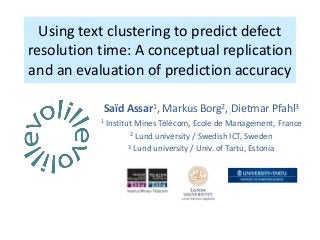
Using text clustering to predict defect resolution time: A conceptual replication and an evaluation of prediction accuracy
- 1. Using text clustering to predict defect resolution time: A conceptual replication and an evaluation of prediction accuracy Saïd Assar1, Markus Borg2, Dietmar Pfahl3 1 Institut Mines Télécom, Ecole de Management, France 2 Lund university / Swedish ICT, Sweden 3 Lund university / Univ. of Tartu, Estonia
- 2. 2 USING TEXT CLUSTERING TO PREDICT DEFECT RESOLUTION TIME: A CONCEPTUAL REPLICATION AND AN EVALUATION OF PREDICTION ACCURACY
- 3. 3 USING TEXT CLUSTERING TO PREDICT DEFECT RESOLUTION TIME: A CONCEPTUAL REPLICATION AND AN EVALUATION OF PREDICTION ACCURACY
- 4. USING TEXT CLUSTERING TO PREDICT DEFECT RESOLUTION TIME: A CONCEPTUAL REPLICATION AND AN EVALUATION OF PREDICTION ACCURACY 4 USING TEXT CLUSTERING TO PREDICT DEFECT RESOLUTION TIME: A CONCEPTUAL REPLICATION AND AN EVALUATION OF PREDICTION ACCURACY Leveraging … textual similarity among defext textual description non-supervised ML to analyse Defect Resolution Time (DRT) Main result : clusters of similar defects have significant differences in mean RT => To which extent does this result hold? Claim : mean RT for clusters of similar defects can be used for DRT prediction => To which extent is this claim valid? Raja (2014). All complaints are not created equal: text analysis of open source software defect reports. Empirical Software Engineering 18:117–138
- 5. Related works (1) 5 Leveraging attributes of previous defects to manage new incoming defects – Attributes: o Severity o Software component o Developer o Textual description o Textual comments o etc. – Goals: o Duplicate detection o Severity prediction o Triaging o Defect resolution time (DRT) prediction o etc.
- 6. Related works (2) DRT prediction using different defect attributes – Kim and Whitehead (2006): descriptive statistics – Panjer (2007), Bougie (2010): different methods and different attributes (excluding textual descriptions) – Anbalagan and Vouk (2009): number of persons as predictor – Giger et al. (2010): different attributes, decision tree analysis – Bhattacharya and Neamtiu (2011): different attributes , univariate and multivariate regression analysis – Lamkanfi and Demeyer (2012): filtering outliers – Zhang et al. (2013): Markov model Prediction using text similarity (Weiss et al., 2007)) 6 Previous defects Prediction set (K=1, 2, 3, … ∞) New incoming defect (textual desc.) Similarity level (α = 0 to 100%)
- 7. Baseline experiment (1) 7 TEXT CLUSTERING TO PREDICT DEFECT RESOLUTION TIME (Raja, 2014) Studied projects (#closed defects) FileZilla (956) jEdit (1682) phpMyAdmin (1521) Pidgin (2689) Slash (3580) Tool support SAS Text Miner Manual preprocessing Removal of report clones Manual examination of issues closed in <1 hour Automatic preprocessing Stop words Stemming Term weighting (entropy weights) Latent Semantic Indexing (LSI) Clustering algorithm Entropy minimization Manual cluster tuning Several labor-intensive steps # of clusters 3-5
- 8. Baseline experiment (2) 8 Statistical test Goal of the test Results Kolmogorov- Smirnov test Normality distribution of DRT among clusters Partially positive – for each project data, “there was a slight violation of normality assumption” for certain clusters (p.129) Levene’s test Equal variance of DRT among clusters Negative – unequal variance for all projects’ data (p.129) One-way ANOVA test Analysis of DRT variance among clusters Positive – for each project, DRT mean of at least one cluster differs from all other clusters (p.130) Brown-Forsythe test Equality of RT means among clusters Positive – the results were consistent, across all projects, with the findings of ANOVA (p.130) Games-Howell’s post-hoc test Identify the exact pattern of differences among clusters’ RT means Partially positive – some of the clusters do not have significant differences in their DRT (p.130) TEXT CLUSTERING TO PREDICT DEFECT RESOLUTION TIME (Raja, 2014)
- 9. Replication (1) 9 A CONCEPTUAL REPLICATION Studied projects (#closed defects) FileZilla (956) jEdit (1682) phpMyAdmin (1521) Pidgin (2689) Slash (3580) Android (4684) – OSS Eclipse (4158) – OSS Company A (6790) – Proprietary Tool support SAS Text Miner RapidMiner Manual preprocessing Removal of report clones Manual examination of issues closed in <1 hour Removal of report clones Automatic preprocessing Stop words Stemming Term weighting (entropy weights) Latent Semantic Indexing (LSI) Stop words Stemming Term weighting (TF-IDF ) Clustering algorithm Entropy minimization K-means clustering Manual cluster tuning Several labor-intensive steps None # of clusters 3-5 4
- 10. Replication (2) 1 0 One-way ANOVA test Brown-Forsythe test Android F=13.47 p-value = 0.0000 *** F=14.03 p-value = 0.0000 *** Eclipse F=21.44 p-value = 0.0000 *** F=18.78 p-value = 0.0000 *** CompA F=92.99 p-value = 0.0000 *** F=48.5 p-value = 0.0000 *** RESULTSRESULTS : CONFIRMATION … Android Cluster 2 Cluster 3 Cluster 4 Cluster 1 0.0004 *** 0.0472 * 0.9127 Cluster 2 0.0000 *** 0.8930 Cluster 3 0.3840 Eclipse Cluster 1 0.0250 * 0.0000 *** 0.9308 Cluster 2 0.0000 *** 0.0000 *** Cluster 3 0.0000 *** Company A Cluster 1 0.0000 *** 0.0000 *** 0.0000 *** Cluster 2 0.0000 *** 0.0000 *** Cluster 3 0.0000 ***
- 11. Simulation (1) 1 1 EVALUATION OF PREDICTION ACCURACY Simulation principles
- 12. Simulation (2) 1 2 EVALUATION OF PREDICTION ACCURACY Simulation principles (cont’d) Magnitude of Relative Error (MRE) accuracy indicator
- 13. Simulation (3) 13 EVALUATION OF PREDICTION ACCURACY Simulation principles (cont’d)
- 14. Simulation (4) Varying the simulation parameters – Error threshold = 25% or 50% – K = 4, 6, 8 and 10 – SSF = 0.1, 0.3, 0.5 The results were globally negative, i.e., no significant difference when compared with naïve prediction 14 EVALUATION OF PREDICTION ACCURACY
- 15. Simulation (4) Results at – K=4 – SSF = 0.1, 0.3 , 0.5 EVALUATION OF PREDICTION ACCURACY
- 16. Simulation (4) Results at with data from Company A only – K=6, 8, 10 – SSF = 0.3 , 0.5 EVALUATION OF PREDICTION ACCURACY
- 17. Conclusion Using a simple, fully automated clustering approach based on term-frequency in defect report descriptions cannot predict DRT with sufficient accuracy Replication without a grounding theory “is by far the most risky type of replication” (Kitchenham 2008) Future work: – Does the similarity assumption hold? – Semantic clustering ? 17
